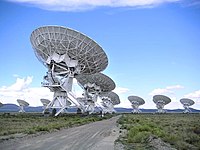A telescope is an instrument designed for the observation of remote objects by the collection of electromagnetic radiation. The first known practically functioning telescopes were invented in the Netherlands at the beginning of the 17th century. "Telescopes" can refer to a whole range of instruments operating in most regions of the electromagnetic spectrum.
The word "telescope" (from the Greek tele = 'far' and skopein = 'to look or see'; teleskopos = 'far-seeing') was coined in 1611 by the Greek mathematician Giovanni Demisiani for one of Galileo Galilei's instruments presented at a banquet at the Accademia dei Lincei.[1][2][3] In the Starry Messenger Galileo had used the term "perspicillum".
The earliest evidence of working telescopes were the refracting telescopes that appeared in the Netherlands in 1608. Their development is credited to three individuals: Hans Lippershey and Zacharias Janssen, who were spectacle makers in Middelburg, and Jacob Metius of Alkmaar[4]. Galileo greatly improved upon these designs the following year.
The idea that a mirror could be used as an objective instead of a lens was being investigated soon after the invention of the refracting telescope[5]. The potential advantages of using parabolic mirrors, primarily reduction of spherical aberration with no chromatic aberration, led to many proposed designs and several attempts to build reflecting telescopes[6]. In 1668, Isaac Newton built the first practical reflecting telescope that bears his name, the Newtonian reflector.
The invention of the achromatic lens in 1733 partially corrected color aberrations present in the simple lens and enabled the construction of shorter, more functional refracting telescopes. Reflecting telescopes, though not limited by the color problems seen in refractors, were hampered by the use of fast tarnishing speculum metal mirrors employed during the 18th and early 19th century—a problem alleviated by the introduction of silver coated glass mirrors in 1857,[7] and aluminized mirrors in 1932.[8] The maximum physical size limit for refracting telescopes is about 1 meter (40 inches), dictating that the vast majority of large optical researching telescopes built since the turn of the 20th century have been reflectors. The largest reflecting telescopes currently have objectives larger then 10 m (33 feet).
The 20th century also saw the development of telescopes that worked in a wide range of wavelengths from radio to gamma-rays. The first purpose built radio telescope went into operation in 1937. Since then, a tremendous variety of complex astronomical instruments have been developed.
Radio telescopes

Radio telescopes are directional radio antennas that often have a parabolic shape. The dishes are sometimes constructed of a conductive wire mesh whose openings are smaller than the wavelength being observed. Multi-element Radio telescopes are constructed from pairs or larger groups of these dishes to synthesize large 'virtual' apertures that are similar in size to the separation between the telescopes; this process is known as aperture synthesis. As of 2005, the current record array size is many times the width of the Earth—utilizing space-based Very Long Baseline Interferometry (VLBI) telescopes such as the Japanese HALCA (Highly Advanced Laboratory for Communications and Astronomy) VSOP (VLBI Space Observatory Program) satellite. Aperture synthesis is now also being applied to optical telescopes using optical interferometers (arrays of optical telescopes) and aperture masking interferometry at single reflecting telescopes. Radio telescopes are also used to collect microwave radiation, which is used to collect radiation when any visible light is obstructed or faint, such as from quasars. Some radio telescopes are used by programs such as SETI and the Arecibo Observatory to search for exterrestrial life. One particularly exciting example is the Wow! signal, recorded in 1977.
[edit] X-ray and gamma-ray telescopes
X-ray and gamma-ray radiation go through most metals and glasses, but some X-ray telescopes use Wolter telescopes composed of ring-shaped 'glancing' mirrors made of heavy metals that are able to reflect the rays just a few degrees. The mirrors are usually a section of a rotated parabola and a hyperbola, or ellipse. Gamma-ray telescopes refrain from focusing completely and use coded aperture masks: the patterns of the shadow the mask creates can be reconstructed to form an image. These types of telescopes are usually on Earth-orbiting satellites or high-flying balloons since the Earth's atmosphere is opaque to this part of the electromagnetic spectrum.


Tidak ada komentar:
Posting Komentar